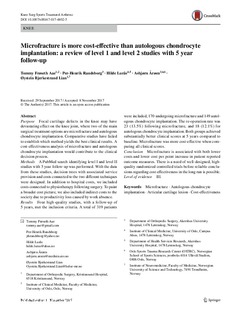| dc.contributor.author | Aae, Tommy Frøseth | |
| dc.contributor.author | Randsborg, Per-Henrik | |
| dc.contributor.author | Lurås, Hilde | |
| dc.contributor.author | Årøen, Asbjørn | |
| dc.contributor.author | Lian, Øystein Bjerkestrand | |
| dc.date.accessioned | 2018-05-23T10:35:38Z | |
| dc.date.available | 2018-05-23T10:35:38Z | |
| dc.date.created | 2017-11-13T13:18:53Z | |
| dc.date.issued | 2017 | |
| dc.identifier.citation | Knee Surgery, Sports Traumatology, Arthroscopy. 2017, 26, 1044-1052. | |
| dc.identifier.issn | 0942-2056 | |
| dc.identifier.uri | http://hdl.handle.net/11250/2498855 | |
| dc.description | This article is distributed under the terms of the Creative Commons Attribution 4.0 International License (http://creativecommons.org/licenses/by/4.0/), which permits unrestricted use, distribution, and reproduction in any medium, provided you give appropriate credit to the original author(s) and the source, provide a link to the Creative Commons license, and indicate if changes were made. | |
| dc.description.abstract | Purpose: Focal cartilage defects in the knee may have devastating effect on the knee joint, where two of the main surgical treatment options are microfracture and autologous chondrocyte implantation. Comparative studies have failed to establish which method yields the best clinical results. A cost-effectiveness analysis of microfracture and autologous chondrocyte implantation would contribute to the clinical decision process.
Methods: A PubMed search identifying level I and level II studies with 5 year follow-up was performed. With the data from these studies, decision trees with associated service provision and costs connected to the two different techniques were designed. In addition to hospital costs, we included costs connected to physiotherapy following surgery. To paint a broader cost picture, we also included indirect costs to the society due to productivity loss caused by work absence.
Results: Four high-quality studies, with a follow-up of 5 years, met the inclusion criteria. A total of 319 patients were included, 170 undergoing microfracture and 149 autologous chondrocyte implantation. The re-operation rate was 23 (13.5%) following microfracture, and 18 (12.1%) for autologous chondrocyte implantation. Both groups achieved substantially better clinical scores at 5 years compared to baseline. Microfracture was more cost-effective when comparing all clinical scores.
Conclusion: Microfracture is associated with both lower costs and lower cost per point increase in patient reported outcome measures. There is a need of well-designed, high-quality randomized controlled trials before reliable conclusions regarding cost-effectiveness in the long run is possible. | |
| dc.language.iso | eng | |
| dc.subject | microfracture | |
| dc.subject | autologous chondrocyte implantation | |
| dc.subject | articular cartilage lesion | |
| dc.subject | cost-effectiveness | |
| dc.title | Microfracture is more cost-effective than autologous chondrocyte implantation: a review of level 1 and level 2 studies with 5 year follow-up | |
| dc.type | Peer reviewed | |
| dc.type | Journal article | |
| dc.description.version | publishedVersion | |
| dc.rights.holder | © The Author(s) 2017 | |
| dc.source.pagenumber | 1-9 | |
| dc.source.volume | Published ahead of print | |
| dc.source.journal | Knee Surgery, Sports Traumatology, Arthroscopy | |
| dc.identifier.doi | 10.1007/s00167-017-4802-5 | |
| dc.identifier.cristin | 1513486 | |
| dc.description.localcode | Seksjon for idrettsmedisinske fag / Department of Sports Medicine | |
| cristin.unitcode | 150,34,0,0 | |
| cristin.unitname | Seksjon for idrettsmedisinske fag | |
| cristin.ispublished | true | |
| cristin.fulltext | original | |
| cristin.qualitycode | 1 | |
